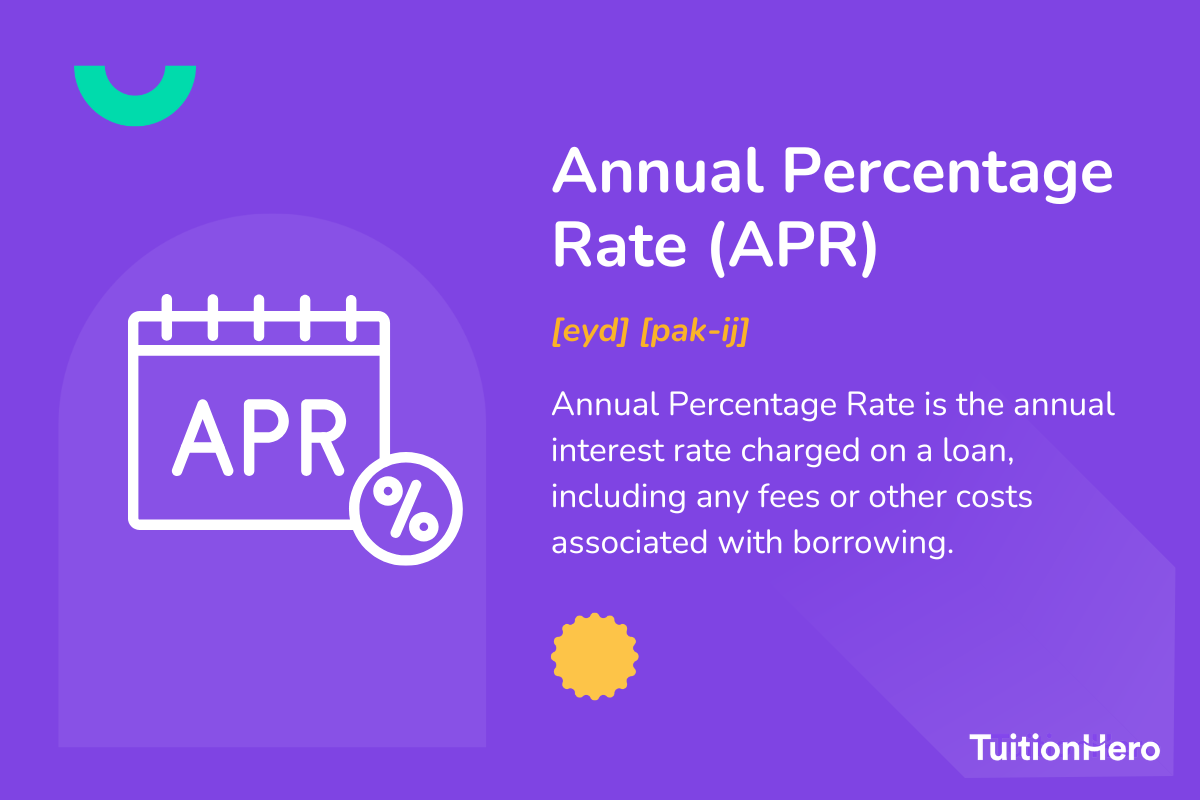Advertiser Disclosure
Last update: November 17, 2024
6 minutes read
Simplifying Credit Card APR
Explore the essentials of credit card APR, learn its impact on your finances, and navigate smart financial decisions with ease.

By Brian Flaherty, B.A. Economics
Edited by Rachel Lauren, B.A. in Business and Political Economy
Learn more about our editorial standards



By Brian Flaherty, B.A. Economics
Edited by Rachel Lauren, B.A. in Business and Political Economy
Learn more about our editorial standards
Struggling to understand your credit card statement? What is a credit card APR? APR stands for Annual Percentage Rate, and it's the amount of interest you'd owe on credit card balances if you don't pay off in full each month. In this post, you'll gain knowledge on all aspects of APR – like its different forms, how to calculate interest, ways to find your credit card’s APR, managing your card strategically to minimize costs, and finally, understanding what makes for a good APR.

Key takeaways
- APR, or Annual Percentage Rate, is the yearly interest you carry if your balance is not paid in time
- Multiple types of APRs exist, like Purchase APR, Introductory APR, Cash Advance APR, and Penalty APR
- Calculating interest using APR is simple with a basic formula: ( APR / 365 ) x average daily balance x days in billing cycle
What is credit card APR?
Credit card APR, or Annual Percentage Rate, is the yearly interest rate you pay if you carry a balance beyond the interest-free grace period. It’s essentially the price you pay for the convenience of borrowing money through your credit card. This rate typically varies based on the type of balance—be it purchases, balance transfers, cash advances, or more.

How does APR work?
When you buy with your card, your credit card’s APR rears its ugly head if you don't repay your balance by the end of the grace period. Grace periods typically last for 21 days following the end of your billing cycle.
The interest on unpaid balances is compounded daily, making it expensive to maintain a balance. Anyone with a credit card must be familiar with how APRs work, when they apply, and how healthy financial habits can help you avoid interest.
What are the different types of APR?
There are several kinds of APRs you should be aware of, including:
- Purchase APR: this is the interest rate charged on all the transactions made with your card, no matter if it's in-person, online, or over the phone.
- Introductory APR: a low or sometimes zero APR that lasts for a promotional period. It applies to purchases, balance transfers, or both. But after the introductory period, the regular APR applies to all remaining balances
- Cash Advance APR: rates for borrowing physical cash from your credit card at an ATM are generally high and come without a grace period.
- Penalty APR: if you miss or return payments, you could be slapped with a high APR, charged on your current balance and future purchases. Credit card issuers might remove it after several consistent on-time payments.
Credit card APR vs. credit card interest
The terms interest and APR are often used interchangeably, and for credit cards, it holds true. For financial products like loans, the APR takes into account yearly borrowing costs, as well as any additional fees.
For credit cards, the interest rate and APR are the same. Your credit card may include additional fees (like annual fees, balance transfer fees, and cash advance fees), but they aren't included in the calculation of APR.
Fixed APR vs. variable APR: what's the difference?
A fixed APR stays the same except in case of a late payment or after an introductory offer ends, providing the comfort of consistent payment planning. However, issuers can change the fixed rate with notice.
A variable APR, on the other hand, goes up and down with the prime rate and could potentially result in lower payments (or higher payments, depending on the market).
How can I find my credit card's APR?
Finding your credit card's APR is straightforward. Your monthly statement will include your APR value for different balances. You may also find it in the account information section if you have an online account, or by referring to the disclosure of terms you received when opening your account.
Compare private student loans now
TuitionHero simplifies your student loan decision, with multiple top loans side-by-side.
Compare Rates
How do I calculate interest using an APR?
Once you've identified your APR, you can calculate your interest using a simple formula:
- Daily rate: Get this value by dividing your credit card’s purchase annual percentage rate by 365. For example, an APR of 24.99% will have a daily rate of .0685%.
- Average daily balance: Add up your balances at the end of each day in the billing cycle and divide the sum by the number of days in the billing cycle to get an average.
- Days in billing cycle: Multiply your daily rate with your average daily balance, and then the number of days in the billing cycle.
For example, for a 31-day cycle with an unpaid balance of $600 throughout the month and an 18% APR, the interest would look like this:
- Daily rate: 18% / 365 = .00049 (.049%)
- Average daily balance: $600
- Total interest: $600 x .00049 x 31 = $9.17
This shows you'd have to shell out $9.17 in interest for that billing cycle, which accumulates more over time if unpaid.
What is a good credit card APR?
Credit card APRs vary based on credit score and different types of cards. However, any APR that falls at or below the national average could be considered good. Check in regularly to stay updated on credit card offers with low APRs from TuitionHero.
Do’s and don'ts of using credit card APR
When it comes to using Credit Card APR effectively, there are several key strategies to follow and pitfalls to avoid. Knowing what to do and what not to do can help you leverage the APR to your advantage without falling into any unnecessary interest traps. Below is a condensed list of the best practices and actions best avoided.
Do
Understand your card's interest rates
Pay off your balance by the end of the grace period
Opt for a card with low or zero Intro APR if you plan on making big purchases
Compare APRs while choosing cards
Make regular full payments
Don't
Assume all card charges have the same APR
Carry a balance beyond the grace period
Not read the fine print for introductory APR period
Apply for cards with High Penalty APR
Miss out on payments

Why trust TuitionHero
At TuitionHero, we’re dedicated to empowering students and parents with the most effective financial tools and support. Our services go beyond private student loans and refinancing; we also help you with scholarships and FAFSA.
We specialize in guiding you in managing credit card offers. We believe that understanding the APR can greatly improve your credit card usage and protect you from potential debt traps. We're here to help you navigate the financial world with confidence and ease.
Frequently asked questions (FAQ)
It depends on your financial situation. A variable APR, linked to the prime rate, can be beneficial if the prime rate drops, as your APR will decrease too and consequently, your payment. However, in a rising rate environment, a fixed APR could be more beneficial as it would remain unaffected.
Applying for multiple credit cards can temporarily dip your credit score, which could affect the APR you’re offered on subsequent card applications. Lenders may perceive you as a greater risk, which could result in them offering you a higher APR. It's always good to research and compare cards before you apply.
Balance transfer APR is often lower than the regular APR or even 0% during the introductory period, which could be a clever way of paying off your debt faster and potentially save you money. However, once the introductory period ends, a higher APR could apply. Make sure to check out our other services at TuitionHero to find the most effective financial strategy for you.
Yes, it's possible to negotiate your credit card's APR with your issuer, especially if you've been a long-standing customer with a solid repayment track record, or if your credit score has improved since you got the card. It never hurts to make a call and ask them to lower your interest rate.
Final thoughts
Understanding the workings of credit card APR can be your key to smart credit decisions. It's more than just a number on your credit card statement.
Responsible usage can open the doors to financial freedom. Remember, a little financial wisdom now can save you from significant worries in the future. Explore our wide range of services at TuitionHero for more insights and help on managing your college finances effectively.
Source
Author

Brian Flaherty
Brian is a graduate of the University of Virginia where he earned a B.A. in Economics. After graduation, Brian spent four years working at a wealth management firm advising high-net-worth investors and institutions. During his time there, he passed the rigorous Series 65 exam and rose to a high-level strategy position.
Editor

Rachel Lauren
Rachel Lauren is the co-founder and COO of Debbie, a tech startup that offers an app to help people pay off their credit card debt for good through rewards and behavioral psychology. She was previously a venture capital investor at BDMI, as well as an equity research analyst at Credit Suisse.
At TuitionHero, we're not just passionate about our work - we take immense pride in it. Our dedicated team of writers diligently follows strict editorial standards, ensuring that every piece of content we publish is accurate, current, and highly valuable. We don't just strive for quality; we aim for excellence.
Related posts
While you're at it, here are some other college finance-related blog posts you might be interested in.
Shop and compare student financing options - 100% free!

Always free, always fast
TuitionHero is 100% free to use. Here, you can instantly view and compare multiple top lenders side-by-side.

Won’t affect credit score
Don’t worry – checking your rates with TuitionHero never impacts your credit score!

Safe and secure
We take your information's security seriously. We apply industry best practices to ensure your data is safe.
Finished scrolling? Start saving & find your private student loan rate today





